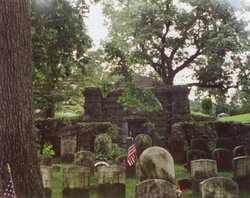Sleepy Hollow Cemetery
|
|
Sleepy Hollow Cemetery is the resting place of numerous famous figures, including Washington Irving, whose story The Legend of Sleepy Hollow is set in the adjacent Old Dutch Burying Ground. Irving's grave overlooks the setting of his best known story. The cemetery is located in the community formerly known as North Tarrytown, New York, which changed its name in 1997 to Sleepy Hollow, New York. Incorporated in 1849, one of Sleepy Hollow Cemetery's founders was Irving himself. Originally named Tarrytown Cemetery, it changed its name to Sleepy Hollow after Irving's death.
This Sleepy Hollow Cemetery (http://www.sleepyhollowcemetery.org) should not be confused with another notable cemetery of the same name in Concord, Massachusetts; see: Sleepy Hollow Cemetery, Concord. Nor should it be confused with the adjacent and much older Old Dutch Burying Ground (http://www.olddutchburyingground.org), the church yard of the colonial-era church (ca. 1685).
The road on which the fictional Ichabod Crane was pursued by the Headless Horseman runs just west of Sleepy Hollow Cemetery and the Old Dutch Burying Ground. The inspirations for the fictional yet lovely Katrina Van Tassel, and her suitors Ichabod Crane and Brom Bones now lie side by side near the Old Dutch Church. They are joined by others whose real-life stories are part of the village's early history. The Rockefeller estate, whose grounds abut Sleepy Hollow Cemetery, contain the private Rockefeller cemetery.
| Contents |
The Old Dutch Burying Ground
ListerGrave-SleepyHollowNY.JPG
- Frederick Philipse (1626-1702) - early settler, founder of the Old Dutch Church in Tarrytown, and builder of Philipse Manor
- Eleanor Van Tassel Brush (1763-1861) (model for Katrina in The Legend of Sleepy Hollow)
- Joseph Youngs (1722-1789) and Susannah Youngs, (1732-1783) were the parents of Samuel Youngs (model for Ichabod Crane). Samuel Youngs was originally buried here but his remains have been removed to Ossining's Dale Cemetery
- Abraham Martling (1743-1830), inspiration for Brom Bones
Sleepy Hollow Cemetery
- Elizabeth Arden (1878-1966), business woman who built a cosmetics empire
- Vincent Astor (1891-1959), philantrophist, member of the Astor family
- Leo Baekeland (1863-1944) - the father of plastic: Bakelite is named for him. The murder of his grandson's wife Barbara by his great-grandson, Tony, is told in the book Savage Grace
- Henry E. Bliss (1870-1955) - devised the Bliss library classification system
- Major Edward Bowes (1874-1946) - early radio star, he hosted an "Amateur Hour"
- Andrew Carnegie (1835 - 1919) - Businessman and philanthropist. In 1918 the Carnegie Foundation established the Teachers Insurance Annuity Association, now TIAA-CREF.
- Walter Chrysler (1875-1940) - businessman, commissioned the Chrysler Building
- Francis Pharcellus Church (1839-1906) - editor at the New York Sun who penned the editorial Yes, Virginia, there is a Santa Claus
- Jasper Francis Cropsey (1823-1900) - landscape painter and architect; designed the now-demolished New York City Sixth Avenue elevated railroad stations
- Samuel Gompers (1850-1924) - founder of the American Federation of Labor
- Mark Hellinger (1903-1947) - film producer. The Mark Hellinger Theater in New York City is named for him
- Raymond Mathewson Hood (1881-1934) - architect
- Washington Irving (1783-1859) - literary author and writer of the famous The Legend of Sleepy Hollow
- George Jones (1811-1891) - one of the founders of the New York Times
- William Rockefeller (1841-1922) - New York head of the Standard Oil Company
- Carl Schurz (1820-1906) - Senator, secretary of the interior under Rutheford B. Hayes. Carl Schurz Park in New York City bears his name.
- Joseph Urban (1882-1933) - architect and theatre set designer
- Henry Villard (1835-1900) - railroad baron
- Thomas J. Watson (1870-1955) - transformed a small manufacturer of adding machines into IBM
- Oswald Garrison Villard (1872-1949) - Son of Henry Villard and grandson of William Lloyd Garrison. One of the founders of the National Association for the Advancement of Colored People.
There is a great deal more to the cemetery than what is visible here. It is very hilly, and has roads so it can be driven through.
There is a roadway (Federal Highway 9) located down a small hill to the left of what is visible in this picture; cars may frequently be heard passing by, doubtless not a feature of the Old Dutch Burying Ground back in Irving's time. Visitors in small but respectable quantities are also common.
See also
External links
- Sleepy Hollow Cemetery (http://www.sleepyhollowcemetery.org)
- Old Dutch Burying Ground (http://www.olddutchburyingground.org)
Template:Geolinks-US-streetscale Template:Geolinks-US-loc Template:Geolinks-US-surroundsde:Sleepy Hollow Cemetery

